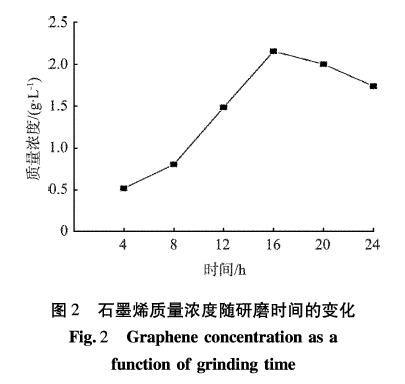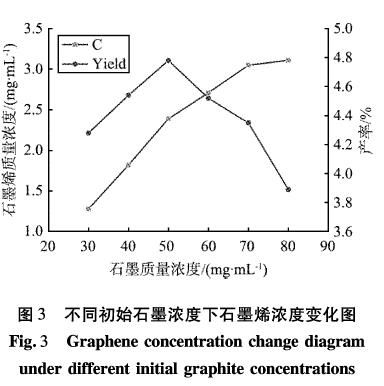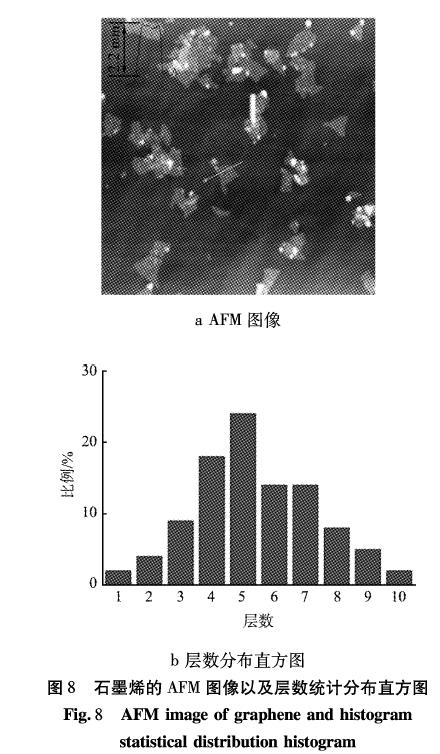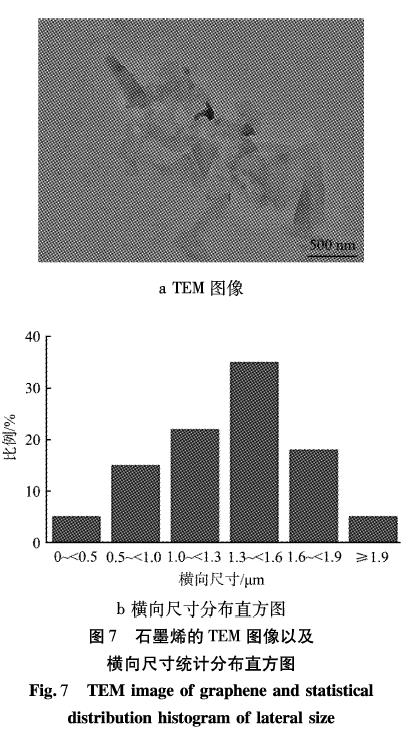In this study, a green wet ball milling method for exfoliating graphene was proposed. A graphene derivative was added to facilitate the ball milling exfoliation of graphite. This additive can effectively intercalate with graphene layers and maintain stable dispersion in water. A planetary ball mill was used to explore the optimal process conditions for milling graphene layers. Under the best conditions, the graphene sheet size was around 1 nm, with more than 60% of the graphene sheets having less than 5 layers.
Experimental
1.1 Materials and Equipment
Main Materials: Expandable graphite with a particle size of 180 µm (purchased from Qingdao Graphite Co., Ltd.), graphene derivative (self-made), deionized water (self-made).
Main Equipment: Electronic analytical balance (FA1004, Changsha Xiangping Technology Co., Ltd.), centrifuge (TG16-11, Changsha Pingfan Instruments Co., Ltd.), freeze dryer (FD-1A-50, Beijing Boyikang Experimental Instrument Co., Ltd.), UV-visible spectrophotometer (UV-5200PC, Shanghai Yuanxi Instruments Co., Ltd.), scanning electron microscope (JSM/701F, JEOL Ltd.), transmission electron microscope (JEM-2100, JEOL Ltd.), atomic force microscope (DM FASTSCAN-i-SYS, Bruker), digital four-probe resistance tester (ST2722-SZ, Suzhou Jingge Electronics Co., Ltd.), planetary ball mill (YXQM-4L, Changsha MIQI Instrument Equipment Co., Ltd.), vacuum atmosphere tube resistance furnace (STG series, Henan Santong Furnace Technology Co., Ltd.).
1.2 Preparation of Graphene
The process for preparing graphene is illustrated in Figure 1. Specifically, a planetary ball mill was employed as the exfoliation equipment, with a nylon jar and zirconia balls used for milling. Different concentrations of the graphene derivative were mixed with a graphite suspension (150 mL) and stirred for 15 minutes to ensure complete dissolution of the graphene derivative and uniform mixing with graphite powder. The resulting mixture was transferred to the nylon jar of the planetary ball mill, and zirconia grinding balls of different diameters (10, 8, 5 mm) were added in a mass ratio of 1:2:3. The sample was then sealed and milled for 4-24 hours at a rotational speed of 320 rpm. After milling, the sample was centrifuged at 4,000 rpm to obtain a clear liquid containing a mixture of graphene and graphene derivative.

1.3 Analysis and Testing
Concentration measurements were performed using a UV-visible spectrophotometer. The degree of defectiveness and the number of layers in the graphene were characterized by Raman spectroscopy, and the ratio of the D peak to the G peak was used as an indicator of graphene defectiveness. The thickness and size of graphene sheets were observed using transmission electron microscopy (TEM) and atomic force microscopy (AFM). The electrical conductivity of graphene powder was determined using a four-probe conductivity tester under a pressure of 22 MPa.

Results and Discussion
During the ball milling process, the high-speed rotation of the planetary ball mill jar, both rotation and revolution, generates shear and collision forces in the jar. The shear force acts on the surface of the graphite and graphene powder, overcoming the weak van der Waals forces between graphite layers, leading to their separation into individual sheets. The collision force results in the breakage and exfoliation of graphite and graphene layers.
Graphene is hydrophobic and does not disperse well in water. However, in the exfoliation process described in this study, the addition of a hydrophilic graphene derivative allowed the exfoliated graphene sheets to effectively bind with the graphene derivative, rendering graphene hydrophilic and dispersible in aqueous solutions.
2.1 Process Parameters
To maximize the concentration of exfoliated graphene and its yield, five key process parameters were investigated. These parameters include ball milling time, the ratio of expandable graphite to graphene derivative, the initial concentration of expandable graphite, and the mass ratio of zirconia grinding balls. All experiments were conducted at a planetary ball mill rotation speed of 320 rpm.
2.1.1 Ball Milling Time
Ball milling time is a crucial factor influencing the effectiveness of graphene exfoliation. Longer milling times lead to increased friction and collision between the balls and the graphite, resulting in better exfoliation. However, excessively long milling times may increase graphene aggregation. After exploring various ball milling times under constant conditions, it was determined that the optimal exfoliation time was 16 hours.
2.1.2 Initial Concentration of Expandable Graphite
The initial concentration of expandable graphite is another critical parameter affecting the concentration and yield of exfoliated graphene. Very high initial graphite concentrations can lead to reduced exfoliation quality and increased aggregation. Thus, an optimal initial concentration range is crucial for effective exfoliation. It was found that an initial concentration of 50 g/L provided the best exfoliation results.
2.1.3 Ratio of Zirconia Grinding Balls
The number and size of grinding balls used are vital for controlling the concentration of graphene exfoliation and the extent of exfoliation. In the study, zirconia balls of three different diameters (10, 8, 5 mm) were employed. Experiments showed that larger ball diameters resulted in less effective exfoliation due to reduced surface area and, thus, fewer collisions. However, when the three sizes of balls were mixed in a ratio of 1:2:3 (10 mm:8 mm:5 mm), a significant increase in concentration was observed, making the combination of different-sized balls more effective. Additionally, it was determined that a 1:60 ratio of ball mass to graphite mass provided the best exfoliation results.
2.1.4 Ratio of Graphene Derivative to Graphite
The ratio of graphene derivative to graphite also plays a crucial role in the exfoliation process. To determine the optimal conditions, a 20:1 ratio was chosen. At this ratio, the concentration of exfoliated graphene reached its peak, and additional graphene derivative did not significantly affect concentration.
By systematically exploring the experimental conditions, the following optimal parameters for exfoliating graphene in a planetary ball mill were identified: a 16-hour ball milling time, an initial concentration of expandable graphite of 50 g/L, a 1:20 mass ratio of graphene derivative to graphite, a combination of zirconia grinding balls with three different diameters (10 mm, 8 mm, and 5 mm) in a 1:2:3 ratio, and a mass ratio of 60:1 for the balls and graphite. Under these conditions, graphene with a concentration of 3.29 g/L and a yield of 4.35% was successfully prepared.
2.2 Characterization
The prepared graphene was characterized using UV-visible spectroscopy, Raman spectroscopy, transmission electron microscopy (TEM), atomic force microscopy (AFM), and electrical conductivity testing.
2.2.1 UV-Visible Spectroscopy and Raman Spectroscopy
The photo of the stable graphene dispersion in water was obtained, and Raman spectroscopy was used to evaluate the graphene's defectiveness and number of layers. The intensity ratio of the D peak to the G peak suggested that the graphene had some defects.
2.2.2 Transmission Electron Microscopy (TEM)
TEM analysis of the prepared graphene revealed irregularly shaped, thin graphene sheets with a lateral size distribution around 0-2 µm. The majority of graphene sheets had lateral dimensions of approximately 1 µm.

2.2.3 Atomic Force Microscopy (AFM)
AFM observations provided insights into the thickness and layer number of graphene sheets. The thickness of the graphene sheets was measured to be 2.2 nm, with an average of 6 layers.
2.2.4 Electrical Conductivity
The electrical conductivity of the prepared graphene was tested, showing a conductivity of 3,600 S/m when subjected to a pressure of 22 MPa. This conductivity was notably higher compared to graphene produced by direct reduction of graphene oxide (232 S/m).

Conclusion
In summary, this study successfully employed a water-based ball milling method to prepare hydrophilic graphene nanomaterials that could stably disperse in water. Optimal processing conditions for graphene exfoliation were identified, resulting in graphene with mostly less than 5 layers, a lateral size distribution of around 1 µm, and an electrical conductivity of 3,600 S/m. This environmentally friendly method, which uses water as a solvent, holds promise for industrial applications.

Submit your demand,
we will contact you ASAP.

Sanxin New Materials Co., Ltd. focus on producing and selling ceramic beads and parts such as grinding media, blasting beads, bearing ball, structure part, ceramic wear-resistant liners, Nanoparticles Nano Powder

